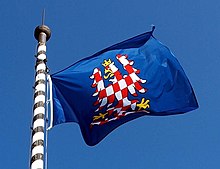


The coat of arms of Moravia has been used for centuries to represent Moravia, a traditional province in the present-day Czech Republic. The coat of arms is also present in a field of the coat of arms of the Czech Republic.
The coat of arms of Moravia is charged with a gold-crowned, white-red-checkered eagle with golden claws, beak, and tongue. The first coat, the seal of the Margraviate of Moravia, is documented only by one worn copy. The gable seal had a design of a lion. The Přemyslid margrave used a seal with a lion in 1239 (as Margrave Vladislav Jindřich had), but the number of tails is unclear; only two are visible on the seal of the margrave (and later king) Ottokar I of Bohemia. The second coat of arms, used from 1233 to 1239, was a typical equestrian one-sided design with the rider bearing an eagle (rather than a lion) on the shield. It is not a Moravian eagle, but a symbol of independence from the Bohemian king in Prague. The seal's equestrian image with an eagle instead of the traditional lion signified the Přemyslid margrave's resistance against Wenceslas I his older brother and king of Bohemia.[2][3][4][5]
In 1758, the citizens of Olomouc were granted the Moravian coat of arms by Maria Theresa in gratitude for their defense against Prussian troops under King Frederick the Great during the Seven Years' War, then with the initials 'F' (for Emperor Francis I), 'M' and 'T' (for Maria Theresa). The coat of arms also appeared on the town seal of Znojmo in 1272, with a 'Z' as its escutcheon. From 1915 to 1918, the Moravian eagle was checkered in red and gold instead of the traditional red and silver.
- ^ "The statue of Jobst of Moravia in Brno was decorated with the Moravian coat of arms, reminiscent of the importance of Moravia". Retrieved 2021-03-31.
- ^ Prinz, Friedrich (1993). Deutsche Geschichte in Osten Europas: Böhmen und Mähren. Berlin: Wolf Jobst Siedler Verlag GmbH. p. 381. ISBN 3-88680-200-0. Retrieved 25 February 2013.
- ^ Maráz, Karel (2014). Sfragistika: studijní texty pro posluchače pomocných věd historických a archivnictví: Panovnická a státní sfragistika. Brno: Masarykova univerzita. pp. 72, 78. ISBN 978-80-210-7143-8.
- ^ "Karel Maráz, Sfragistika: studijní texty pro posluchače pomocných věd historických a archivnictví: Panovnická a státní sfragistika, Brno, 2014, s. 70-95" (PDF). Retrieved 2020-02-13.
- ^ Valecký, Štěpán (2017). Erb českých králů. Zobrazování českého znaku v době Přemyslovců a Lucemburků (in Czech). Praha: Univerzita Karlova v Praze, Katolická teologická fakulta. pp. 30, 37, 39–40, 41.